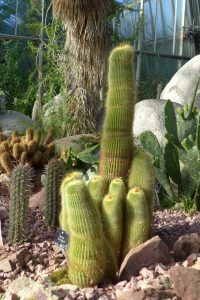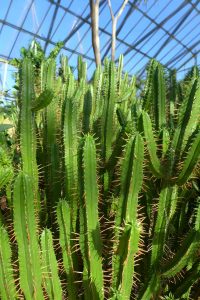Audio by David Mitchell from 2005
This house displays some of the adaptations plants have made to the prolonged droughts and extreme temperatures of the desert regions across the world.
The display in this house is divided in to two sections; the New World (the Americas) and the Old World (Asia and Africa).
The Americas are closest to you, with the Old World at the far end of the glass house, the areas are separated by a sculpture of a puddle with two toads. These are Couch’s spadefoot toads, inhabitants of the Sonran desert in the US. They spend most of the year asleep, waiting underground for the rain. This is just one example of how life has evolved to survive in this hostile environment.
Some of the plants on display here are a fantastic example of convergent evolution; where two different groups adapt in very similar ways.
Whilst it may look like there are cacti growing in both the New World and the Old World displays, this isn’t the case – with only a very small number of exceptions, cacti are only found in the New World. Those plants which have very similar form – an enlarged stem with a concertina-like edge, no leaves and spines are in fact members of the genus Euphorbia. This genus has a large number of species, around 200-300 of which are succulent, typically the others are herbaceous. The two can be told apart by several features – Euphorbias always produce a white latex, whereas cacti don’t. The spines also differ, with those of Euphorbia being arranged in pairs along the stems, whereas in cacti they are in groups in growing from a small cushion-like area. The flowers also differ, with those of cacti tending to be large and showy, whereas those of the Euphorbias are quite small and insignificant.



2 Comments
2 Pingbacks